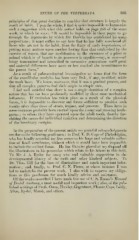Page 493 - My FlipBook
P. 493
TEETH OF THE VERTEBRATA. ' 503
principles of that great doctrine to consider that structure is largely the
result of" habit. Upon the whole, I find it quite impossible to harmonize
such a suggestion with what this author holds on page 268 of the same
work, in which he says : " It would be impossible in these pages to go
through the arguments by which Mr. Darwin has established his main
propositions ; it must suffice to say here that he has fully convinced all
those who are not in the habit, from the fixity of early impressions, of
putting many matters upon another footing than that established by the
exercise of reason, tliat any modification in the structure of a plant or
animal which is of benefit to its possessor is capable—nay, is sure—of
being transmitted and intensified in successive generations until great
and material differences have more or less masked the resemblances to
the parent form."
As a result of palseontological investigation we know that the form
of the mandibular condyles has been very little, if any, modified, while
the teeth have. We know, moreover, that it was a gradual process, and
that all com])lex patterns had their origin in simj)le ones.
I feel well satisfied that there is not a single dentition of a complex
nature that has not been profoundly modified by these same mechanical
influences. If evolution has taken place as a result of the physical
forces, it is impossible to discover any forces sufficient to produce such
results other than those of strain, impact, and jiressure. These have in
some instances })robably been exerted upon the young and growing tooth-
germs ; in others they have o]>erated upon the adult tooth, thereby fur-
nishing the causes for individual variation and determining the direction
of the hereditary energies.
In the preparation of the present article my grateful acknowledgments
are due to the following gentlemen : to Prof. E. D. Cope of Philadelphia,
who has kindly accorded me free access to his large and valuable collec-
tion of fossil vertebrates, without which it would have been impossible
to include the extinct forms. He has likewise placed at ray disposal all
the illustrations in his jjossession which relate to his labors in this field.
To Mr. J. A. Ryder for many wise and valuable suggestions in the
developmental history of the teeth and other kindred subjects. To
Dr. Theo. Gill for the loan of illustrations and much important infor-
mation ; and, finally, to Prof. C. N. Pierce, at whose instance I was
led to undertake the present work. I also wish to express my obliga-
tions to this gentleman for much kindly advice and assistance.
Of the' works consulted I have made free use of C. S. Tomes's Manual
of Dental Anatomy, a most useful and important work ; also, of the pub-
lished writings of Profs. Owen, Huxley, Gegenbaur, Flower, Cope, Leidy,
Allen, Ryder, Marsh, and others.


